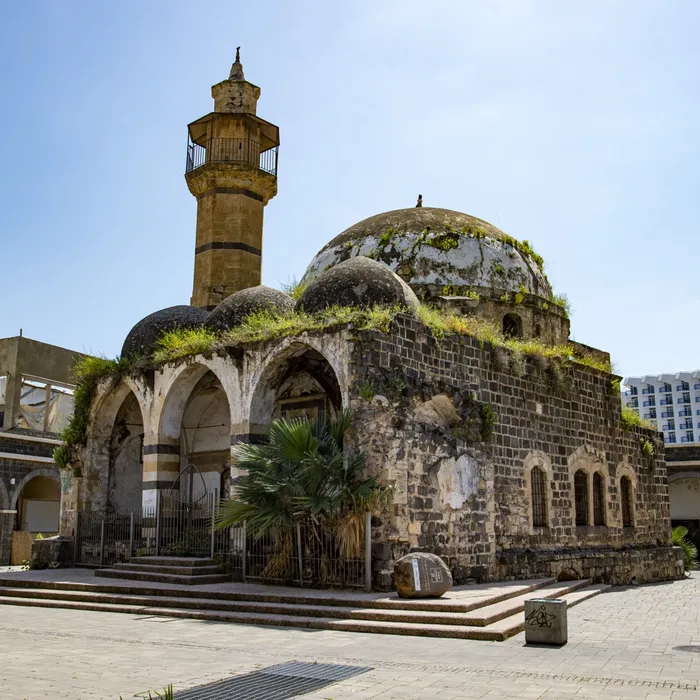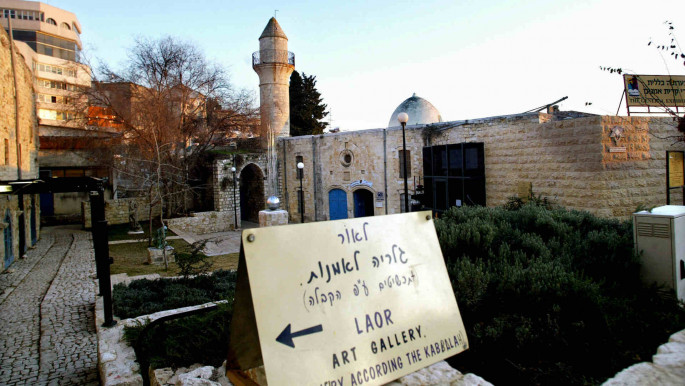Israel has converted many mosques in the areas it occupied into temples, barns, and stables, while many mosques inside Palestinian territories suffered intentional distortion and neglect by Israel since the Nakba in 1948.
Misuse of Mosques
In 1743, Zahir bin Omar al-Zaydani, one of the rulers in Palestine during the Ottoman rule, established a mosque named “Zahir Omar al-Zaydani” in the city of Tiberias (north), but “intentional Israeli neglect” turned it into an abandoned building.
The mosque has a Mamluk architectural style, topped by a large dome preceded by three smaller domes, and behind them is a minaret, making it one of the most important landmarks in Tiberias.

The head of the Freedoms Committee of the High Follow-up Committee for Arab Citizens in the Palestinian Territories, Sheikh Kamal Khateeb, said in a statement to Anadolu Agency: “Like other Palestinians, many residents of Tiberias migrated to Syria and Lebanon after the Nakba of 1948, but the Zaydani family, whose roots go back to Zahir Omar al-Zaydani, moved to the nearby city of Nazareth (north).”
Since then, the mosque has been closed, and Israeli occupation authorities do not allow worshipers or visitors to enter it. Khateeb adds that “years ago, the Zaydani family requested permission from the Israeli authorities to allow them to renovate the mosque, but the municipality of Tiberias refused,” claiming that it would take care of renovating the mosque itself, but everything remains the same.
Mosques’ Destruction
There are about one and a half million Palestinian citizens in Israel (occupied territories in 1948), according to Israeli official statistics, and Palestinians date mosques in Israel before and after the Nakba of 1948. Some are still standing, while others have been destroyed, and a third category is used for purposes other than what they were built for.
In a study conducted by Khateeb, he documented 15 mosques converted into churches and Jewish temples, 40 mosques demolished, closed, or neglected, in addition to 17 mosques converted into barns for sheep and cows, restaurants, taverns, museums, and warehouses.
The study also indicates that the Red Mosque in the city of Safed (north) has been converted into a meeting place for artists, where wedding parties are held, while the New Mosque in the city of Caesarea (north) has been turned into a restaurant and tavern.

The same fate befell the Ain Hawd Mosque in Haifa district (north) and the upper floor of the Al-Siksik Mosque in Jaffa (central).
Mosques After the Nakba
Khateeb says, “After the Nakba and the destruction of 539 Palestinian villages, the Israeli institution, unfortunately, dealt with the Palestinian interior as if it were cut from a tree, as the proverb says,” adding that Palestinian properties, including mosques, became vulnerable to Israel.
Khateeb also points out that “before the Nakba, mosques were thriving, with worshipers attending prayers, but during and after the Nakba, mosques were demolished, especially in the villages that were destroyed, and some mosques were diverted from their intended purposes, such as being turned into churches, barns for sheep and cows, museums, cafes, and taverns.”
Khateeb gives examples such as “the Qaysariya Mosque, part of which has been turned into a restaurant and tavern, and the other part into an art gallery, and the Afula Mosque turned into a synagogue, and the Bisan Mosque turned into a museum.”
Khateeb adds, “Israeli policy in this regard disregards our feelings as Muslims… This is currently evident in the Asaf cemetery in the city of Jaffa, where graves of this historic Islamic cemetery are being excavated despite protests from residents.”
Absentee Property Law
According to Khateeb, what is happening with the properties of Palestinian citizens who emigrated or were displaced in 1948 applies to mosques as well. He said, “After the Nakba, the Israeli Parliament passed the Absentee Property Law, which treated Arab citizens’ properties as belonging to non-existent persons, thus Israel placed its hand on their properties and mosques, and in the same way, seized many mosques and prayer rooms.”
Despite repeated attempts to reclaim mosques, stop encroachment on them, or even renovate them, Israeli authorities have not agreed. According to Khateeb, during tours in cities with Jewish or mixed Jewish-Arab majorities in Israel, mosques can be noticed by their minarets, but not all of them are mosques until now.
Israeli Claims
Officially, Israel denies converting mosques for purposes other than their intended ones. The Israeli Foreign Ministry said in October 2015: “According to the Ministry of the Interior data, there are about 400 mosques in Israel. The number of mosques has increased fivefold over the past 25 years.”
The ministry also claimed that “the Israeli Ministry of Religious Affairs allocates millions of shekels annually to build religious buildings for Muslims in Israel.”
But Sheikh Khateeb says that “the Israeli government has never built any mosques. All mosques were established at the expense of our people, who form committees and collect donations to build mosques.”
Sunna Files Free Newsletter - اشترك في جريدتنا المجانية
Stay updated with our latest reports, news, designs, and more by subscribing to our newsletter! Delivered straight to your inbox twice a month, our newsletter keeps you in the loop with the most important updates from our website












